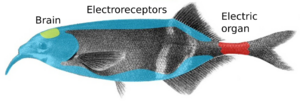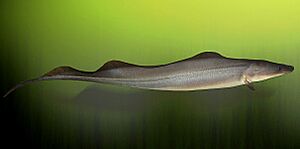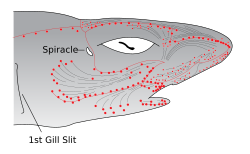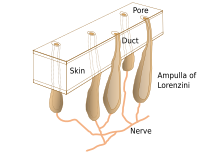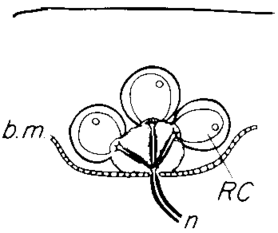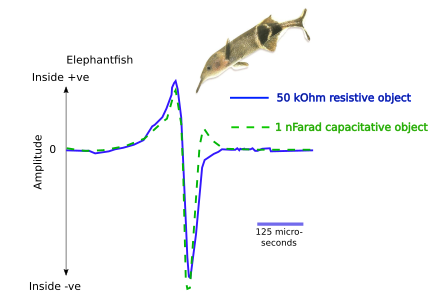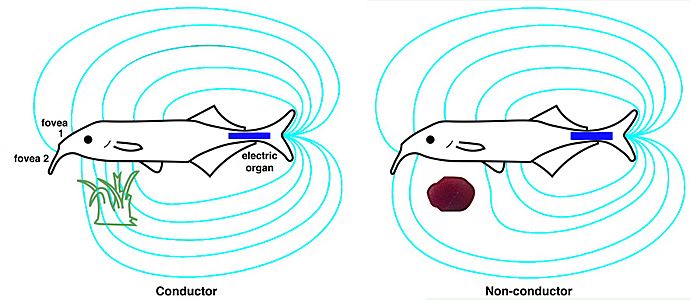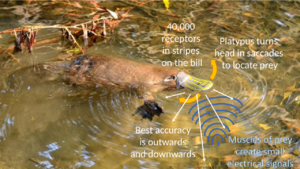Electroreception and electrogenesis facts for kids
Electroreception is a special sense that allows animals to detect electric fields. Electrogenesis is the ability to create electric fields. These two abilities often work together. Many animals use them to find food, especially in dark or murky water. Some fish, like the electric eel, can even create strong electric shocks to stun their prey!
These abilities are mostly found in animals that live in water. This is because water is much better at carrying electricity than air.
There are two main ways animals use electroreception:
- Passive electrolocation: The animal senses electric fields made by other living things, like the tiny electric signals from a hidden fish's muscles.
- Active electrolocation: The animal creates its own weak electric field. Then, it senses how this field changes when it hits objects. This helps the animal "see" its surroundings, even in the dark.
Two groups of fish are famous for active electrolocation: the knifefishes (like the electric eel, which is actually a type of knifefish, not a true eel!) and the elephantfishes. These fish use a special part of their body called an electric organ, which is made from changed muscle cells in their tail.
If the electric field is just strong enough to detect things, it's called a weak electric field. If it's powerful enough to stun or kill prey, it's called a strong electric field. Some fish, like elephantfishes, send out short electric pulses. Others, like many knifefishes, send out a continuous electric wave.
Some strongly electric fish, like the electric eel, first use a weak electric field to find prey. Then, they release a strong electric shock to stun it. Other strong electric fish, like the electric ray, only use passive electrolocation. Stargazer fish are unique because they can create strong electric shocks but don't use electroreception to find things.
The first known electric sensors in animals are called ampullae of Lorenzini. These evolved very early in the history of animals with backbones. You can find them in sharks and rays, and also in some bony fish like coelacanths and sturgeons. Most bony fish later lost these sensors. However, other types of electroreceptors have developed many times in different animals, including two groups of mammals: the monotremes (like the platypus and echidnas) and some dolphins.
Contents
History of Discovery
In 1678, an Italian doctor named Stefano Lorenzini found special organs on the heads of sharks. These are now called the ampullae of Lorenzini. But it wasn't until 1960 that R. W. Murray proved these organs could sense electricity.
In 1921, a German scientist named Viktor Franz described other special organs, called knollenorgans, in the skin of elephantfishes. He didn't know what they did at the time, but we now know they are also electroreceptors.
A big discovery happened in 1949. A Ukrainian-British zoologist named Hans Lissmann noticed something amazing about the African knife fish (Gymnarchus niloticus). This fish could swim backward just as fast and skillfully around obstacles as it could swim forward! In 1950, Lissmann showed that the fish was creating an electric field and reacting to any changes in it. This proved that fish could "see" with electricity.
How Animals Use Electrolocation
Animals use electroreception to find things around them. This sense is super helpful in places where they can't see well. For example, in dark caves, in muddy water, or at night.
Electrolocation can be:
- Passive: Sensing electric fields that others create.
- Active: Creating a weak electric field and sensing how it changes.
Passive Electrolocation
In passive electrolocation, an animal senses the weak electric fields made by other animals. All animals create these fields because of their nerves and muscles working. Fish also create electric fields from their gills when they breathe.
Passive electroreception usually uses sensors like the ampullae of Lorenzini. These sensors are good at detecting low-frequency electric signals, like those from a living creature. They have a jelly-filled tube that goes from the sensor to the skin surface.
Active Electrolocation
In active electrolocation, an animal senses its surroundings by creating weak electric fields. It then detects changes in these fields using special electric sensors. The electric field is made by a special electric organ, which is made of changed muscle or nerve cells.
Animals that use active electroreception include weakly electric fish. Some, like the elephantfishes, send out small electric pulses (called "pulse-type"). Others, like the knifefishes, produce a continuous electric wave (called "wave-type").
Many of these fish, like the African knife fish and the glass knifefish, keep their bodies stiff. They swim forward or backward easily by wiggling fins that run along most of their bodies. Swimming backward might help them search for food using their electric sense. These fish can even pick out bigger water fleas from smaller ones, even in the dark!
These fish create a very small electric field, usually less than one volt. Weakly electric fish can tell the difference between objects that conduct electricity well and those that don't. This helps them identify objects. Active electroreception usually works within about one body length. Objects that conduct electricity similarly to water are hard to detect.
Active electrolocation uses special sensors called tuberous electroreceptors. These are sensitive to high-frequency electric signals. Elephantfish have tuberous electroreceptors called Knollenorgans and Mormyromasts in their skin.
Elephantfish send out short pulses to find their prey. Objects that conduct electricity (like plants) and objects that resist electricity (like stones) affect the electric field differently. This allows the fish to find different types of objects within about a body length. Objects that conduct electricity well make the pulse stronger. Objects that resist electricity cause distortions in the pulse.
-
For the elephantfish, the electric organ in the tail (blue) makes an electric field (cyan). Sensors in the skin detect this field. The fish has two "electric pits" (foveas) to actively search for objects. You can see how the field changes around a plant (green) that conducts electricity better than water, and a stone (brown) that doesn't conduct electricity well.
The knifefishes, including the glass knifefish and the electric eel, are different from elephantfishes. They send out a continuous electric wave, like a smooth sound wave. Just like elephantfishes, this electric field helps them tell the difference between objects that conduct electricity and those that resist it.
Electrocommunication
Weakly electric fish can also talk to each other by changing the electric waves they create. They might use this to attract mates or to show other fish who owns their territory. Electric catfish often use their electric zaps to scare away other types of fish from their hiding spots. But with their own kind, they usually have "fights" with open mouths and sometimes bites, rarely using electric shocks.
When two glass knifefishes get close, they both change their electric signals. This is called a "jamming avoidance response" and helps them avoid confusing each other's signals.
Some bluntnose knifefishes create electric signals that are similar to the weak electric signals of the electric eel. Scientists think this might be a type of Batesian mimicry. This means they are pretending to be the dangerous electric eel to scare away predators. Male bluntnose knifefishes make a continuous electric "hum" to attract females. This uses a lot of their energy! Females prefer males with stronger signals.
Fish that hunt electrolocating fish can "eavesdrop" on their prey's electric signals to find them. For example, the African sharptooth catfish might hunt the weakly electric elephantfish this way. This has led to an "evolutionary arms race," where the prey fish develop more complex or higher-frequency signals that are harder for predators to detect.
Some shark embryos and baby sharks will "freeze" (stop moving) if they sense the electric signal of a predator.
Evolution of Electroreception
In animals with backbones, passive electroreception is a very old trait. This means their earliest ancestors had it. The original way of sensing electricity is called ampullary electroreception, named after the ampullae of Lorenzini. These sensors developed from the lateral line organs, which help fish feel movement in water.
You can find these sensors in:
- Cartilaginous fish (sharks, rays, chimaeras)
- Lungfishes
- Bichirs
- Coelacanths
- Sturgeons
- Paddlefishes
- Aquatic salamanders
- Caecilians
It seems that most bony fish and land animals (tetrapods) lost their ampullae of Lorenzini early in their evolution. However, when electroreception appears in these groups, it has developed again later in evolution, using different organs.
Electric organs have evolved at least eight separate times in different groups of animals!
Cartilaginous Fish
Sharks and rays (a group called Elasmobranchii) rely on electrolocation during the final steps of their hunts. They can be tricked into attacking if they sense electric fields similar to those of their prey. Sharks are known to be the most electrically sensitive animals, able to detect very tiny electric fields.
Bony Fish
Two groups of bony fish are weakly electric and use active electroreception: the knifefishes from South America and the elephantfishes from Africa. This ability helps them navigate and find food in cloudy water. The electric eel, a type of knifefish, can also create strong electric shocks to stun its prey. These powerful electric shocks come from large electric organs made of modified muscles. These organs are like stacks of tiny batteries, adding up their small voltages to create a powerful shock.
Monotremes
Monotremes, which include the platypus and echidnas, are the only mammals that have developed electroreception. Unlike fish and amphibians, whose electric sensors came from lateral line organs, monotremes' sensors are in their skin glands and connected to nerves in their snout.
The platypus has the best electric sense among monotremes. It has almost 40,000 electroreceptors arranged in stripes on its bill. These sensors are very good at detecting things to the sides and below. By making quick head movements, platypuses can accurately find their prey. The platypus seems to use both its electric sense and pressure sensors to figure out how far away prey is.
The electric sense of the four types of echidnas is simpler. Long-beaked echidnas have about 2,000 sensors, while short-beaked echidnas have about 400 near the tip of their snout. This difference makes sense because of where they live and what they eat. Long-beaked echidnas eat earthworms in wet forest leaf litter, where electric signals travel well. Short-beaked echidnas eat termites and ants, which live in drier nests. Scientists think the echidna's electric sense might be a leftover from an ancestor that was more like a platypus.
Dolphins
Dolphins have also developed electroreception, but in different body parts than fish, amphibians, and monotremes. The hairless pits on the snout of the Guiana dolphin (Sotalia guianensis), which used to have whiskers, can sense electricity. They can detect very small electric fields, enough to find small fish. This sensitivity is similar to that of the platypus.
Bees
Until recently, we only knew about electroreception in animals with backbones. But new research shows that bees can also detect the static electric charge on flowers!
See also
 In Spanish: Electrorrecepción para niños
In Spanish: Electrorrecepción para niños
- Active sensory systems
- Feature detection (nervous system)
- Magnetoreception


